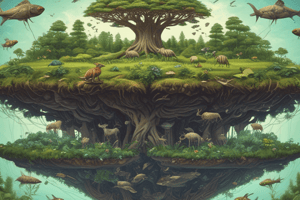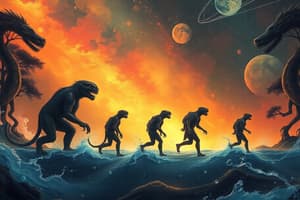Podcast
Questions and Answers
What is natural selection?
What is natural selection?
- A process where characteristics of a population change over generations. (correct)
- A process that occurs without any environmental influence.
- A process that guarantees survival.
- A process that only occurs with human intervention.
What is selective pressure?
What is selective pressure?
An abiotic or biotic environmental condition that selects for or against certain characteristics in individuals.
Natural selection anticipates changes in the environment.
Natural selection anticipates changes in the environment.
False (B)
What does fitness describe in evolutionary biology?
What does fitness describe in evolutionary biology?
What is artificial selection?
What is artificial selection?
The key difference between natural selection and artificial selection is that in natural selection the environment plays the role that __________ plays in artificial selection.
The key difference between natural selection and artificial selection is that in natural selection the environment plays the role that __________ plays in artificial selection.
What are gene banks?
What are gene banks?
Which crops are the result of artificial selection?
Which crops are the result of artificial selection?
What is monoculture?
What is monoculture?
Flashcards are hidden until you start studying
Study Notes
Natural Selection
- Natural selection leads to changes in a population’s characteristics over generations due to diversity within a species.
- Essential for natural selection is the presence of variation among individuals in a species.
Selective Pressure
- Selective pressure can arise from abiotic (non-living) environmental conditions, influencing certain traits in individuals.
- Biotic factors, such as interactions with other organisms, can also create selective pressures.
Nature of Natural Selection
- Natural selection is situational, dependent on current environmental conditions, and does not predict future changes.
- It operates without intention or foresight, lacking will, purpose, or direction.
Fitness
- Fitness measures an individual's contribution to the gene pool of future generations based on their offspring's survival and ability to reproduce.
Artificial Selection
- Artificial selection is a human-driven process where selective pressures are applied to modify or enhance desirable traits in populations.
- A common example of artificial selection is selective breeding.
Differences between Natural and Artificial Selection
- The primary distinction is that in natural selection, environmental factors drive the process, while humans exert control in artificial selection.
Artificial Selection in Food Crops
- Major food crops such as rice, corn, and wheat have been developed through selective breeding to increase nutritional content and yield.
- Selective breeding has shaped the varietals of vegetables and other essential crops for human consumption.
Monoculture
- Monoculture involves planting large expanses of land with a single variety of species, which can lead to issues related to biodiversity and resilience.
Gene Banks
- Gene banks preserve a variety of early ancestors of modern plants, maintaining genetic diversity.
- These resources provide potential genetic material for future agricultural needs or improvements.
Studying That Suits You
Use AI to generate personalized quizzes and flashcards to suit your learning preferences.




